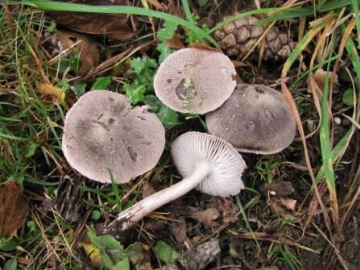Mill Green Common : Much of the former heath has been overrun by secondary woodland in the past few decades, resulting in a disastrous loss of species diversity, the remaining mix of heather and gorse being confined to a small triangle of land opposite The Cricketers pub. This too is now under attack by birch saplings, some already twenty feet tall, and during the last two winters Rob Smith - the EFC Butterfly Recorder - and myself have been attempting to stem the tide. Several of the birches were cut down in the past and have coppiced into multi-stemmed stools. We had been hoping to poison the stumps but there are health and safety issues when using such chemicals in public places. Those we re-coppiced last winter were sprouting well by early March and I fully expected the young coppice to be three feet tall by the time we resumed work in November. Fortunately, the large local deer population came to our rescue. Much maligned for destroying the shrub layer in coppiced woodlands they did us a favour by constantly nibbling the young growth throughout the summer, eventually killing the stools. By early spring this year we should have got the invasive birch under control and hope that the two large clearings created will eventually be re-colonised, if not by Heather then at least by Gorse, as even decent stands of the latter are all but gone from the Writtle Forest area. Already, last year's clearing has been colonised by three species of heath-land grasses, Purple Moor, Tufted Hair and Mat Grass, together with large quantities of Sheep's Sorrel, so things are looking hopeful.
The dead birch stools have sprouted large numbers of Turkey Tail Trametes versicolor and Tripe Fungus Auricularia mesenterica while the pleasantly mild and damp weather so far this winter has meant that several species of fungi, usually long since killed off by the frosts, have continued to fruit into the New Year. Finds this week have included three kinds of Clitocybe - Clouded and Winter Funnels C.nebularis & C.metachroa at Waterhall Meadows, Little Baddow, and Trooping Funnel C.geotropa, at Fryerning. The Deceiver Laccaria laccata is still fruiting on my garden lawn and Honey Fungus Armillaria mellea agg is polishing off what little remains of my peach tree. At The Backwarden EWT Reserve Common Earthballs Scleroderma citrinum were still pumping spores into the air on 4th and among a number of little brown jobs growing on fallen branches that I did my best to ignore was one I recognized, namely, Angel's Bonnet Mycena arcangeliana. The best finds of the week, though, were at Fryerning Churchyard - a large group of Grey Knight Tricholoma terreum (illustrated) and the Honey Waxcap Hygrocybe reidii, which, as its name suggests, smells of honey - or so the person I asked to smell it informs me. Having no sense of smell I have no idea what honey smells like!
Despite the mild weather there are few insects to be seen yet. The garden moth trap yielded a Mottled Umber on 1st, we disturbed several 7-spot Ladybirds while working at Mill Green on 2nd and flushed the winter flying micro moth Agonopterix heracliana at The Backwarden on 4th. It's been a good week for birds, though; highlights being a flock of 100+ Siskins feeding in Alders at Harding's Farm, Ingatestone on 1st, a Peregrine (a scarce bird inland in Essex) at The Backwarden on 4th and a Black-necked Grebe and a delightfully tame Lapland Bunting at Blue House Farm EWT Reserve on 6th
Happy New Year!


















